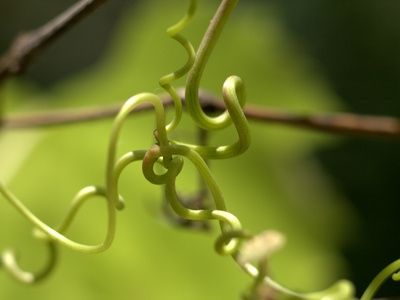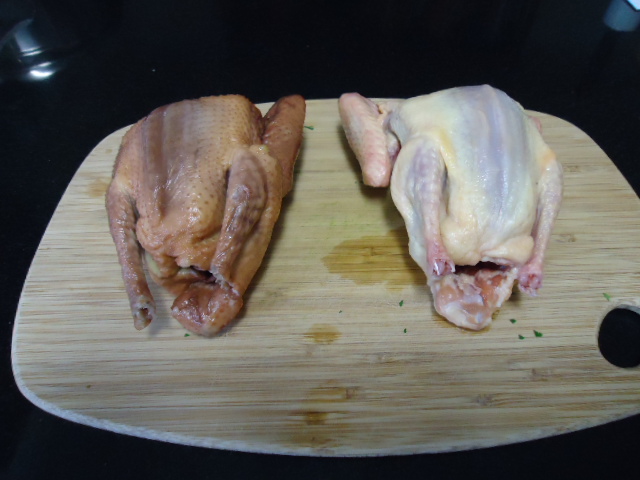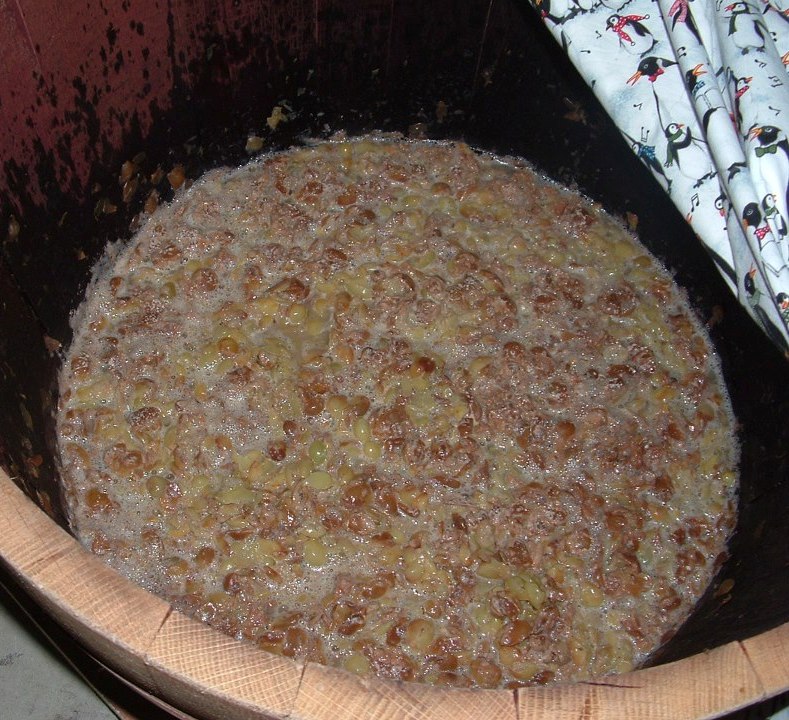| | So brewing is quite a long process. Mostly it seems to be lots of activity, then lots of waiting in between activities. I think it helped that we had help along the way, and could phone a friend when we were unsure. It helps that he sent us the right ingredients too :)
We've tried both strong and a weak (or Small) ale. Basically the strong ale is use all your ingredients as per the recipe, and the small ale, is use all your leftovers again to eke anything out that you can.
The strong ale (Great Ale?) is now in the fermenters, and the kitchen smells of a really nice spiced bread.
And the small ale is now in the plasterers bucket (which has contracted in quite an amazing manner) ready to be brought out and brewed closer to the time. A good result all round, with the barley water being quite sweet and clear before it was put into the fermenter. Let's hope it works! |
| | So yesterday was presentation day for Round 1. It was good to see all our stuff in one place at one time. There were some fantastic entries by a lot of teams, and most had gotten the message that they needed to explore more than one aspect of their element, and all tried something new to them. Most explored some version of cooking (as it has a quick turnaround) but each team had at least one other option, which was great to see.
Our presentation looked great, thanks to Francesca's efforts to secure appropriate feast ware, and also to Muirghein's sea shell inspiration. Francesca, Portia, and Maeve all assisted in presenting this to the judges and talking them through. People seemed to really enjoy the taste of the chicken dishes, particularly the Mawmenny redux, and loved the colour of the Grape Relish, and the Vine Tendril Black. Two things we didn't do very well - we didn't write up documentation for the raisins (!), and we forgot to take photos (thankfully Stella Guo did!)
| There were some great explorations, with some particularly difficult challenges that teams had set themselves. Well done to Crispin (Burbage - Fat) for learning drop spindle both flax and hemp in order to make both tallow and beeswax candles; Fiorella for taking her team (Descartes Specials - Tin) through the tin glaze project; and to Ben the Undecided (Rouge et Valois - Fungus) for his first ever recipe redaction of a german stuffed mushroom recipe that tasted divine. Huge props to Alexandra and Zenobia (Sew & Swear - Sugar) for their making sugar from cane; for the many types of soap explored by Ragnhildr (Cooks Guild - Lemon); and for the College of Saint Andronicus tackling the hardest one (bone) up front, and making dice, wax tablet & stylus, and bone marrow pie.
Looking forward to seeing even more teams rise to the challenge next time!
| As with any historical reenactment or experimental archaeology, not everything you do is going to be a fabulous success. Here are our favourite two failures from working with Grapes...
The complete non-starter award goes to Vine Tendril Pie. Given how keen we were to use as much of the grape plant as we could, we were keen to give things ago that involved the stalk, stem and leaves - that weren't dolmades! Platina to the rescue. This recipe involved cutting green vine tendrils (which was no easy feat - these things are tenacious in their ability to hold on.. to eachother, the fence wire, garden furniture...) and boiling them to make sure they were completely soft for a new spin on a quiche florentine. After an hour of boiling these new shoots were incredibly tough, bitter, and the colour of bile. Needless to say, we didn't bother baking the pie!
The amusing, but completely disastrous award goes to the Pigeon Soaked in Vinegar to make it boneless - a recipe from Platina which Scully also refers to. It didn't make the pigeon boneless - it made the pigeon inedlible. All you could taste was the vinegar and the meat was actually tougher as a result of being immersed in vinegar for so long. The control roast pigeon was a lot tastier. So the boneless pigeon is not going to be presented on the 10th.
|  Vine tendrils  Pigeon soaked in vinegar (left) compared with the control pigeon. |
| | One week later it is time to strain the fermenting grapes, and get rid of the grape skins, before putting the proto-wine in a sealed container to complete fermenting.
Even though it seemed like a small amount, it took all hands on deck to actually manage the process, so they're aren't many photos. You can see the barrel uncovered, with the bubbling grape mush - evidence of fermenting!
From 15 kilos of grapes, we now have about 5 litres of liquid hapily bubbling away in our baby fermenter... I promise that it smelled better than it looked! |
| From our intrepid chef, and her tasting team: Well, the recipe testing went well yesterday.
The Sawse Madame was fantastic (I substituted mint and thyme for the hyssop and savoury) and I want to cook this again for a dinner party.
The original recipe for Mawmenee was cooked and even Muighein thought it was too sweet. I've kept that sauce in a jar in the fridge to let the unsuspecting masses try it. I then did another redaction of the recipe, this time using significantly less sugar and it worked really well. Not everyone's cup of tea and needs to be mopped up with bread, but will be good to present.
- Francesca | |
| | Saturday was a busy day for these pentathletes - winemaking and lots of cooking.
As you would imagine, the basics were - wash and de-stalk the grapes. Then press them to squeeze out the juice. Well, in the 14th century they were stomping it (see the Holkham Bible illustration in the picture). So, with our disposable apprentice away, Muirghein volunteered to give it a go. Apparently it is quite pleasant, although rather cold. And there was a bit of messing about to get the technique right - fresh washed grapes are slippery suckers!
After all the fun was over, we added the sulphide (to sterilize) and the yeast (for fermentation). Given we were going for an open fermentation process, we only covered this with a cloth, to make sure no unanticipated ingredients made their way into the mash. Now to ferment for a week...
|
| When looking for unusual things to do with grapes, we came across a recipe labelled grape relish. Even though it was not specifically datable to 14thC England, we decided it just sounded too interesting not to try - plus it allowed us to use black grapes, where all our other activities used white.
First we washed and de-stalked the grapes, then pounded them, and added the breadcrumbs, verjuice and spices. Then we simmered the relish over the stove. This was when we realised this was much more of a sauce - and a sweet one at that.
After simmering it for half an hour, we took it off the stove, and pressed it through a mill. And the result was a fantastic rich purple sauce - very decadent. The only problem was that there wasn't very much as at reduced quite a lot - enough for us all to taste some, and bottle about a cup worth. | | Relish it isn't, but it is a really lovely tasting sauce. And have you ever seen such a fantastic purple in a dish before?
| | On our first big project day, we thought we would start with something easy - making fresh verjuice. This is unfermented grape juice, usually from underripe grapes to produce one that has tang rather than sweetness. We chose this project early on because we needed to get to the grapes in Muirghein's back yard before they ripened. This ended up being a much bigger effort than we thought, and gave us a new appreciation for this ingredient.
Based on an estimate of 5 kilos of grapes for about a litre of verjuice, we started with picking enough grapes, then getting them off the stem. From here we needed to juice them. While we tried the food mill, it just couldn't process the grapes - they were too big, and often too solid. | We fell back on crushing them with our fingers, and also tried pressing them through a seive. While both were effective, they weren't getting the juice out efficiently. At this point we fell back on putting the partially squashed grapes into some cooking muslin, and squeezing the juice out. This was more effective, but still left some grapes almost in tact. However given this was now about 3 hours into the process, we decided that was good enough!
At this point we wanted to clarify the verjuice, as there was a lot of sediment. We strained it through a linen cloth (a tea towel that was sacrificed for the job, and the verjuice came out reasonable clear (the tea towel will never be the same). Our hands were quite stained with the process also. But in the end our verjuice looked pretty good, and we stored some in a jar to settle, and froze some. Both will be tried later to see how they have fared. The final photo in the series above shows (left to right) strained verjuice, unstrained verjuice, and commercial verjuice for comparison.
| Our first activity was to try making vine tendril charcoal for our black pigment. Muirghein found the reference in Theophilus, and Portia cut the dry vine tendrils from a dead grape vine. As there was no specific recipe for how to create this charcoal, we then took them to Sui to get some help, and he walked us through the process of creating charcoal from the vine tendrils.
Essentially charcoal is created by burning something in a restricted space - in this case a milo tin that had been used before to create charcloth. We packed the tin as full as possible of vine tendrils, placed the lid on it with a small hole, and then put it on the barbecue. As the tendrils heated, they off-gassed, and this caught fire - you know your substance has become charcoal when this fire goes out. | | At the end of the process, we tested the blackened tendrils in a small brazier with a flint and steel to check that we had definitely created charcoal. Success! Now to make the pigment by grinding it all up...
|



 RSS Feed
RSS Feed